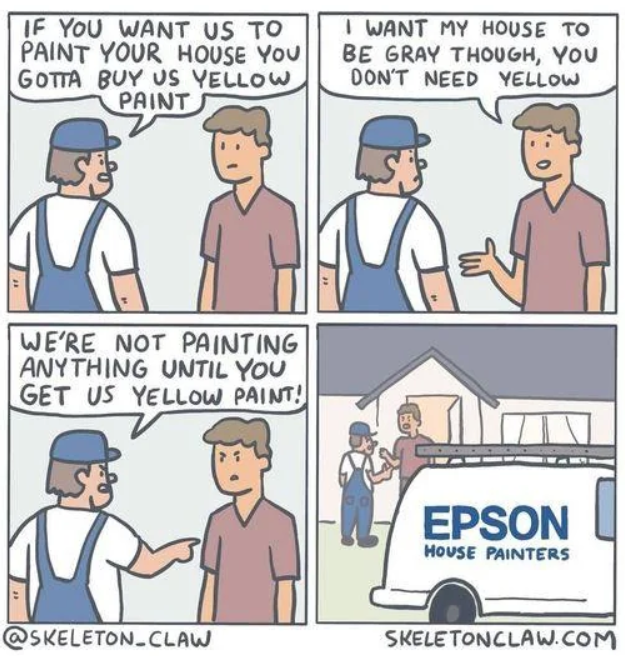this post was submitted on 01 May 2025
858 points (99.2% liked)
iiiiiiitttttttttttt
957 readers
77 users here now
you know the computer thing is it plugged in?
A community for memes and posts about tech and IT related rage.
founded 3 months ago
MODERATORS
you are viewing a single comment's thread
view the rest of the comments
view the rest of the comments

That is NOT the reason. FFS. If that was the case, you couldn't switch to B&W only printing when you're out of one of the cartridges, and, shocker!, you almost always can (assuming that you don't have the absolutely worst printer driver in existence).
I work in commercial printing, and I print in CMYK every single day. Almost nothing is absolutely pure cyan, magenta, yellow, or black. Printing pure black ends up looking like a very washed out charcoal grey. If you want 'rich black'--which is what most people think of as black, you need to us C,M, and Y. If you had a spectrophotometer and were creating color profiles for your printer, you'd be able to very, very quickly see that. (You'd also be able to see that the colors used in most inks and toners isn't strictly linear, and that you can start getting weird 'hooking' in colors once you exceed a certain ink volume. Some inks are much worse than others in that respect.) Depending on the RIP software that you're using, and how you create the color profile for the printer, you can specify exactly where greys switch from being monochromatic (K only) to using the full gamut.
It used to be really apparent with our old Roland printers, where you could easily see the individual pixels with a magnifying glass. Now we're using printers that are higher resolution--I think 600ppi natively, but I see enough dot gain in what we're printing on that anything past 150ppi is irrelevant--you can't see them.
There's a collection of images that I have to print regularly from one of our corporate clients. This collection of images is always sent as greyscale .tif files. When you look at them on-screen, they look fine. When you print them, they're washed out. The issue is that the RIP software sees the images in greyscale, and defaults to using K only. If I convert the images to RGB (which, yes, I know, it's weird that I print in RGB when the printer is CMYK, but trust me, it improves color slightly), then the printed image looks like the image on screen.
It may not be true for commercial printing, but it is absolutely true for all consumer printers made since the mid 1990s.
Some can produce B&W identification marks, but every consumer printers stamps every single page printed with identification marks with at minimum the printer model and serial number.
Right, but that's not the reason it won't print if you're out of a color. Especially since you can still print in B&W only mode. Or you certainly used to be able to, but I'm still using the same color laser from >10 years ago for home use, and an old Brother photo printer for things that need to be higher resolution.
If you use a Brother printer with ecotank cartridges, you can get an empty yellow cartridge and fill it with water if you're worried about tracking dots. You'll want to run a few cleaning cycles first to ensure that all the residual yellow is gone from the yellow print head.
...Or you can buy a typewriter at a pawn shop with cash, and dump it once you've written the ransom note/bomb threat. If you're counterfeiting stuff, you should probably consider the printer to be a consumable item that gets discarded and replaced after every batch.
Also, not every printer made since the mid-90s does that. See here